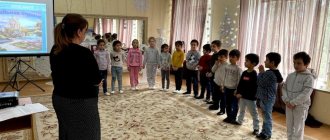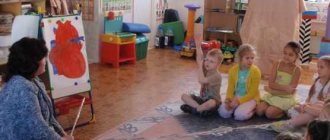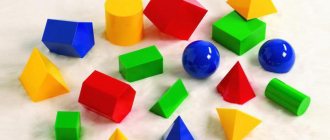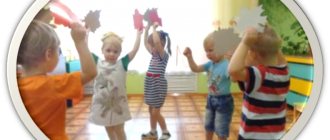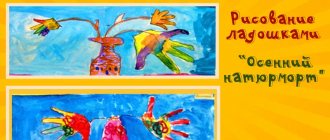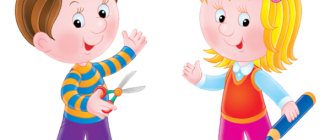conclusions
The main task of a parent when teaching a child to draw is to instill an interest in creativity. To make your child love to draw, do not bother him with advice, appreciate his efforts. Give your child the opportunity to draw freely, do not hamper his imagination with ready-made templates, this is the only way he can fully develop his creative potential. Introduce your child to aesthetics, choose books with good quality illustrations, well-drawn cartoons, and, if possible, visit museums and exhibitions.
Problems solved using free drawing
Description of the technique
Classes are held in a group and, less frequently, individually. Each listener receives a sheet of paper, paint (non-toxic gouache or watercolor), brushes and a jar of water. The first instruction is given: “You see paints in front of you. Take the ones you like and draw." Only those who find themselves in difficulty are given the following clarification: “If you don’t know what to draw, draw stripes.” This is why colored stripes are a component of many designs, but no one is limited to them. Authors who have completed the drawing receive the next sheet, and so on, as long as the desire to draw remains. Discussion follows. Everyone talks about their feelings during the drawing process. The remaining participants express their impressions (feelings, associations) in connection with the drawing. On the back, the author signs the drawing and indicates with arrows the sequence of development of the image on paper.
Problems solved using free drawing
Current. Expression in the drawing and awareness when discussing one’s own psychological motives, attitudes, feelings, relationships. Change of feelings under the influence of free drawing. Achieving better mutual understanding and self-understanding. Accepting each person's individuality (as expressed in their drawing). Awareness of the need to introduce a child to spontaneous visual activities from an early age.
Changes in feelings under the influence of free drawing (how feelings change is described in the example below)
. Free drawing helps to discover, express experiences and, as a result, change them. The dynamics of feelings can be traced in a number of sequential drawings.
(An example for course leaders to understand) This happened with Katya L’s drawings. She made the first drawing under the impression of the explosion of a neighboring house that occurred the following night: a sheet of paper was covered with stripes from top to bottom: first blue, then yellow, green, again yellow and light -blue. Thus, as the paper was filled, the colors became lighter. She made the second drawing from the bottom up and completed it with an image of a house. According to subjective sensations, during the process of drawing, the feeling of anxiety that oppressed the woman (she came to class with tears in her eyes) weakened and ceased to burden her.
Thus, the free drawing technique is a necessary component of psychological work with the family during the period of expecting a child, performing a number of tasks, both relevant during pregnancy and long-term, aimed at the development of the child in the future.
2. What follows is the pregnant woman’s story about what she drew for her experiences.
3. Next, I propose to ask the question, What do you need so that fear ceases to be fear? To neutralize him? Or reduce it.
Sometimes pregnant women (and all of us) are simply afraid and give in to fear. Our task is to acknowledge fear and look at it from the outside. And maybe you can see how to reduce it.
For example:
A pregnant woman is afraid that she will not be able to cope with the child after birth. And he draws his fear and names it. And we ask her a question: What do you need so that fear ceases to be fear? To neutralize him? Or reduce it. And she suddenly realizes that fear is not abstract, but that there is a real opportunity to reduce it. She answers: ask your sister for help, invite a breastfeeding consultant, study the necessary information on the course, etc....
4. Of course, there are fears that cannot be completely removed; they are not subject to anyone except God. Then our task is to reduce the power and impact of this fear. We ourselves do not mention such horrors out loud to pregnant women, so that their imagination does not run wild, and so as not to give them new fears. They talk about them themselves.
!!!!!For fear of pain
(which is to some extent inevitable, of course) I propose the following.
Why does a woman need childbirth? -ask pregnant women. What will they answer?
During childbirth, not only a new life is born, but also a “mother”. Childbirth is about patience, which will now be vital. The value of a child increases during childbirth, because It would be strange to give birth without pain and sensations, to awaken some emotions in a woman. Childbirth is the beginning of new challenges and childbirth is the first stage.
Why is pain needed? What did the pregnant women say? - childbirth begins at night, pain is needed so that the female does not sleep and is alert, otherwise she will oversleep and trouble may happen. Pain is adrenaline, which means the meeting with the child will be as emotional as possible in order to awaken the maternal instinct and in order to lock the child in with the mother, and not with those who are still present at the birth (then it would not matter who the newborn is given to)
NATURE HAS PROVIDED EVERYTHING, EVERYTHING THAT HAPPENS IS ALL NECESSARY.
Out of 10 hours of labor, 2 hours of contractions and only the last 2 hours are as intense as possible
(according to the calculations of the candidate of biological sciences Lansburg, I did not recalculate). Can I be patient??????
!!!!!I also suggest meditation for all fears beyond our control,
in which we agree, YES, there is fear, I am familiar with it, but I can live with it and use it to my advantage.
Fear is my assistant, it is a hint indicating what needs to be paid special attention to, it is an ally. Thanks to our fears, we came to the courses! Fine? Certainly! We are looking for a good obstetrician, maternity hospital, pediatrician, consultant. Fine? Great! We are looking for information to be fully armed, we are preparing for a new rhythm of life. And all this development is thanks to our fears! After all, in the end, fear will remain an imaginary, imaginary event, and how many positive results and achievements are thanks to our fears!!!
Thanks to our fears!
So, auto-training or meditation.
I close my eyes and take a deep breath and exhale smoothly.
I see my fear, it can be big or small, round or square, gray, black or another dark color. I look at him, I look at him.
I see it and concentrate on it, I see nothing but my fear, I have it. Name your fear. What is this fear? What are you afraid of?
I start cleaning my fear, maybe vacuuming, maybe washing, maybe sweeping or laundering, as you like. It begins to brighten. I clean it until it becomes light, clean, possibly transparent.
Give your fear a name, a nickname, or just a name. How can you call him affectionately, perhaps with humor?
Hello my fear (call it by name). Now I will call you that, only by name. Thank you for having me. I thank you for your help. I know you.
I promise you that I will always remember you and will never forget about you. I will wish you good morning and good night. I will greet you every time I think of you.
Therefore, you can be calm and not remind yourself. There is no need to come to me, I will call you when I need you.
I take a deep breath and exhale smoothly and open my eyes.
After the meditation, homework assignments until the birth. Find or buy some item at home (for example, an unnecessary soft toy) and assign it that same fear. Place her in a prominent place and call her by the same name that she was given during meditation. And greet him when passing by (Oh, hello, cousin!) Do not forget to greet him and wish him good night)))
The goal is to recognize it, be able to live with it, make it common in your life. As a result, it will become familiar and you will stop noticing it. You will stop noticing your fear!!!!!!
5. One more point in working with fears.
You ask pregnant women what your mother told you about her birth.
.
3 minutes and they write about it. Let's discuss further.
Often we don’t even realize how deeply our mothers’ birth experience has ingrained itself in us.
! Very rarely was it positive.
They remember that mom couldn’t, it was embarrassing, it wasn’t nice, phrases like “yes, you’ll never be able to feed, because... you have the same breasts as me, and I had little milk, etc….” And we talk.
In this task, it is important to talk about this experience so that it comes to the surface from the subconscious. When a pregnant woman confronts this experience, she realizes that it can interfere with her labor. And now she can sort it out for herself, because now she knows everything about childbirth!
Information for pregnant women!
- Your birth, breastfeeding, etc. are individual, exact repetition is not possible!!! This has been confirmed by thousands and millions of births!
- We don’t even know what kind of woman in the family is pregnant genetically. looks like repeating someone's birth scenario. No program!
“Our mothers did not have the knowledge, they were trained to give birth on the run, throw the child in the nursery, not feed, not pick up the child and run to build a bright future! Can they have other experiences other than negative ones?
- You will not be like your mother, you are not a mother, besides, you also have your dad.
If the pregnant woman wishes, she can correct her drawing at the end of the lesson and show that she is the mistress herself and decides for herself whether to be afraid or not. Everything is in her hands
| To ruin the birth, you need to come to the birth in fear, squeeze and be afraid. Hormones of fear block the hormone of childbirth - oxytacin and natural pain relief - endorphin. |
Recommended pages:
Use the site search:
Long-term work plan for fine arts and the development of creative abilities in the middle group
Direct educational activity “Autumn Tree”
Objectives: To introduce signet printing techniques.
Develop a sense of composition and drawing Objectives: Practice drawing oval-shaped objects and typing with signets.
Strengthen the ability to decorate objects with a simple pattern (a strip of dots) using finger painting. Develop a sense of composition. Joint activity of the teacher with children Didactic game “What went wrong?”
Objectives: To develop children's observation skills, to teach them to identify color properties by comparing one object image with others in terms of presentation.
Didactic game “Let’s decorate the scarf”
Objectives: To develop the ability to understand the laws of composition, to select various combinations of colors, using them in decorative appliqué. Bring children to understand that the beauty of a pattern depends on the repetition of the same elements of the same color.
Independent activity of children Involve children in decorating the bedroom for the Masha doll (drawing carpets on the wall, rugs on the floor, beautiful napkins on the table). Develop spatial imagination. Provide different options with the right to choose the implementation technique.
Work with parents Conduct a survey of parents on the topic: “What does your child draw?” Folder “The role of drawing in a child’s life”
Direct educational activity “Autumn Forest” (team work)
Objectives: To introduce I. Levitan’s painting “Golden Autumn”, with how the artist conveys the beauty of autumn nature; consolidate the ability to draw trees, convey the beauty of autumn nature, color; develop the ability to draw on one sheet of paper, creating teamwork.
"Sunflowers"
Objectives: Practice finger painting. To develop the ability to draw the stem and leaves of a sunflower. Strengthen your gouache drawing skills. Develop a sense of composition.
Joint activity of the teacher with children Didactic game “Find the same”
Objectives: To consolidate the ability to recognize and correctly name the color blue, to distinguish four shades of blue. Reinforce the concept of “color”, “shade”. To develop the ability to consistently select shades of blue in descending order of lightness.
Thematic leisure: “Fairytale forest”
Objectives: To arouse children’s interest in fairy tales and develop their imagination. Bring joy from meeting familiar fairy-tale characters. Develop the ability to use acquired skills and abilities.
Independent activity of children Encourage children to create scenery for a play based on the fairy tale “Caprizka” by author. T.N. Karamanenko and Yu. G. Karamanenko.
Work with parents Consultation on the topic: “Introduction to non-traditional drawing techniques” (phytodesign)
Direct educational activity “My favorite fish”
Objectives: Practice drawing oval-shaped objects. Introduce the technique of combining wax crayons and watercolors. Develop the ability to tint a sheet of paper with different watercolor colors. Develop color perception.
"Edible Kingdom"
(phytodesign using appliqué technique) Objectives: Developing a holistic perception of the subject. To develop the ability to identify different types of cereals by touch. Learn to make a composition from different types of cereals.
Joint activity of the teacher with children Didactic game “Magic colors”
Objectives: To consolidate children's knowledge about the color green. Develop the ability to obtain green color by mixing two primary colors on the palette: blue and yellow. Practice differentiating blue, yellow and green colors.
Didactic game “Find the extra square”
Objectives: Practice solving problems based on the ability to establish similarities and differences between visually perceived color images. Continue to develop the ability to exclude a dark-colored object from a variety of light ones.
Rules for drawing with a child
The main task of a parent when teaching a child to draw is to instill an interest in creativity. And if a child refuses to draw, most likely this is not due to a lack of creative abilities, but is the result of mistakes in parenting. To avoid common mistakes and develop your child’s creative potential, adhere to the following rules:
- Don't interfere. You should not impose your vision of the result on your child, or give advice and recommendations if your child does not expect them from you. Your comments may improve the quality of a particular drawing, but they will not have a long-term effect. Let your child enjoy the process and independently evaluate their work.
- Don't overdo it with auxiliary tools. Coloring books and all kinds of drawing tutorials are very popular with both children and parents. However, we must not forget that they are only good for the development of fine motor skills and patterned thinking, while a blank sheet of paper is better suited for the development of a child’s creative abilities, creativity and imagination.
- Introduce your child to aesthetics. What a child sees around him depends on what patterns for drawing will form in his head. Choose books with high-quality illustrations, well-drawn cartoons, and, if possible, introduce your child to art.
- Set an example. To teach your child to draw, lead by example. This applies not only to template images (for example, a house, the sun, a tree), but also to drawing techniques. Introduce your child to different strokes, show that paint can be splashed, mixed, etc. Then the child will develop a wonderful basis for independent drawing.
- Appreciate your child's creativity. Under no circumstances do you throw away drawings in front of your child, and don’t brush your child off if he shows you his work. Let your child know that you are proud of him! Arrange a home exhibition of drawings, and you can sign old works and put them in a folder.
Stages of development of children's drawings
| Age | Contents of drawings |
| Up to 1.5 years | Stroke stage. At this age, children enjoy the colorful marks they can leave on paper. Provide your child with as many creative materials as possible so he can express himself. |
| 1.5 – 3.5 years | Doodle stage. The drawings made by children at this age do not differ in appearance from the drawings of the previous stage, but the child already puts his own meaning into them, wanting to depict something specific. |
| 3.5 – 8 years | Schematic stage. At this age, children usually begin to draw familiar houses, flowers, and the sun. The child depicts only the important details of the object, without taking into account the proportions. |
| 8 – 10 years | Stage of plausible images. Children at this age try to depict the object as accurately as possible, details are drawn, proportions are taken into account. |
| After 10 years | Correct images. The drawings become three-dimensional and realistic. |
Experts separately highlight the features of children’s depiction of humans:
| Age | Features of the image of a person |
| 4 years | The body is usually round or oval, there is no neck. The proportions are not respected. |
| 5 years | Gender differences appear (girls and boys are depicted differently), details (ears, hair, clothes). |
| 6 years | Drawing small details, maintaining proportions. The neck is shown. |
| 7 years | The drawing becomes more realistic. The face can be drawn not only from the front, but also from the profile. |
| 8 years | The line of the neck, shoulders and arms is continuous. |
| 9 years | A person can be depicted in various poses, and movement is captured. |
| 10-11 years | The desire to create a three-dimensional image. |
